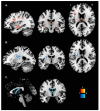Macrostructural and Microstructural White Matter Alterations Are Associated with Apathy across the Clinical Alzheimer's Disease Spectrum
- PMID: 36291317
- PMCID: PMC9599811
- DOI: 10.3390/brainsci12101383
Macrostructural and Microstructural White Matter Alterations Are Associated with Apathy across the Clinical Alzheimer's Disease Spectrum
Abstract
Apathy is the commonest neuropsychiatric symptom in Alzheimer's disease (AD). Previous findings suggest that apathy is caused by a communication breakdown between functional neural networks involved in motivational-affective processing. This study investigated the relationship between white matter (WM) damage and apathy in AD. Sixty-one patients with apathy (AP-PT) and 61 without apathy (NA-PT) were identified from the Alzheimer's Disease Neuroimaging Initiative (ADNI) database and matched for cognitive status, age and education. Sixty-one cognitively unimpaired (CU) participants were also included as controls. Data on cognitive performance, cerebrospinal fluid biomarkers, brain/WM hyperintensity volumes and diffusion tensor imaging indices were compared across groups. No neurocognitive differences were found between patient groups, but the AP-PT group had more severe neuropsychiatric symptoms. Compared with CU participants, only apathetic patients had deficits on the Clock Drawing Test. AP-PT had increased WM damage, both macrostructurally, i.e., larger WM hyperintensity volume, and microstructurally, i.e., increased radial/axial diffusivity and reduced fractional anisotropy in the fornix, cingulum, anterior thalamic radiations and superior longitudinal and uncinate fasciculi. AP-PT showed signs of extensive WM damage, especially in associative tracts in the frontal lobes, fornix and cingulum. Disruption in structural connectivity might affect crucial functional inter-network communication, resulting in motivational deficits and worse cognitive decline.
Keywords: Alzheimer’s disease; apathy; white matter.
Conflict of interest statement
The authors declare no conflict of interest.
Figures



Similar articles
-
Plasma neurofilament light levels correlate with white matter damage prior to Alzheimer's disease: results from ADNI.Aging Clin Exp Res. 2022 Oct;34(10):2363-2372. doi: 10.1007/s40520-022-02095-y. Epub 2022 Feb 28. Aging Clin Exp Res. 2022. PMID: 35226303
-
White matter integrity and key structures affected in Alzheimer's disease characterized by diffusion tensor imaging.Eur J Neurosci. 2022 Oct;56(8):5319-5331. doi: 10.1111/ejn.15815. Epub 2022 Sep 9. Eur J Neurosci. 2022. PMID: 36048971
-
Widespread white matter aberration is associated with the severity of apathy in amnestic Mild Cognitive Impairment: Tract-based spatial statistics analysis.Neuroimage Clin. 2021;29:102567. doi: 10.1016/j.nicl.2021.102567. Epub 2021 Jan 19. Neuroimage Clin. 2021. PMID: 33545500 Free PMC article.
-
Diffusion tensor imaging of white matter degeneration in early stage of Alzheimer's disease: a review.Int J Neurosci. 2020 Mar;130(3):243-250. doi: 10.1080/00207454.2019.1667798. Epub 2019 Sep 24. Int J Neurosci. 2020. PMID: 31549530
-
The role of diffusion tensor imaging and fractional anisotropy in the evaluation of patients with idiopathic normal pressure hydrocephalus: a literature review.Neurosurg Focus. 2016 Sep;41(3):E12. doi: 10.3171/2016.6.FOCUS16192. Neurosurg Focus. 2016. PMID: 27581308 Review.
Cited by
-
Mapping the Neuropsychiatric Symptoms in Alzheimer's Disease Using Biomarkers, Cognitive Abilities, and Personality Traits: A Systematic Review.Diagnostics (Basel). 2025 Apr 24;15(9):1082. doi: 10.3390/diagnostics15091082. Diagnostics (Basel). 2025. PMID: 40361900 Free PMC article. Review.
-
The clinical and neuropsychological profiles of Alzheimer's disease with white matter hyperintensity in North China.Front Neurol. 2024 Oct 2;15:1436030. doi: 10.3389/fneur.2024.1436030. eCollection 2024. Front Neurol. 2024. PMID: 39416665 Free PMC article.
-
Neuropsychiatric symptoms and white matter hyperintensities in older adults without dementia.Int Psychogeriatr. 2024 Nov;36(11):1051-1063. doi: 10.1017/S1041610224000607. Epub 2024 Apr 19. Int Psychogeriatr. 2024. PMID: 38639110 Free PMC article.
References
Grants and funding
LinkOut - more resources
Full Text Sources

